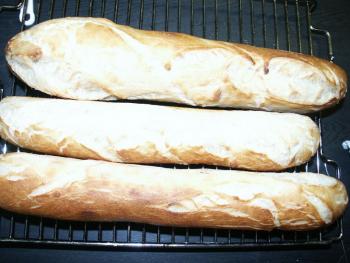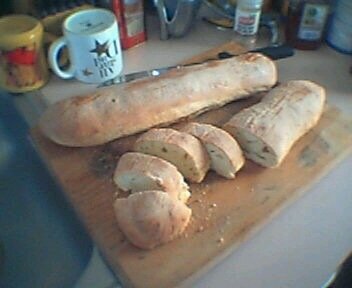my Freeform Loaf with Preferment - Part I
[size=+3]my Freeform Loaf with Preferment - Part I[/size]
with apologies to Lewis Carroll
"The time has come," the Walrus said,
"To talk of many things:
Of bread--and stoves--and temperatures--
Of oven loft in recipes--
And why this dough just will not rise!
ah Reader! Help me please."
[size=+1]
A Few Preliminaries[/size]
Having poured over pancake's valiant and ultimately successful venture making Peter Reinhart's baguette recipe using "pate fermentee", I too was inspired to attempt a bread using "pate fermentee" where the loaf is baked freeform on a flat surface rather than in a loaf pan. I chose his recipe for
Pain de Compagne (aka
Country Bread) which is quite similar to his baguette recipe posted in this thread.
In his discussion, Reinhart assures us that
This particular dough never disappoints.
Alas, I hereby attest and affirm that it
does disappoint, at least it unkindly did so for me.
Now whether this is due to...
> my inexperience and ineptitude making freeform loaves
or
> my failure, to date, to purchase
the baking stone I lust after
or
> a peculiar spitefullness towards me by the spirits of grains and flour
or
> some other cause which has yet to be determined by you, dear Reader
...it remains that my attempts to date have ranged from total failure to only partial success. While the bread rises quite nicely in the bowl it fails to rise much in the oven, resulting in a loaf with a dense crumb, not the open-holed "airy and fluffy" product achieved by pancake.
I now proceed to share my...
[size=+1]
Failures and One Partial Successs[/size]
My Failures: Baking Directly on the Pan
In these attempts, after the dough had risen in the bowl, I simply shaped it into a ball (aka a
boule for you Frenchies out there) and let it rise on a small pizza pan well sprinkled with coarse corn meal. When the dough had risen approximately 1-1/2 the original size, I put it, still on the pan, into a preheated
500F oven, steamed the oven by pouring 1 cup simmering water into a preheated castiron frying pan on the floor of the oven, reduced the heat after 5 minutes to 450F and hovered anxiously in the kichen until it was done.
Here is the last attempt (my first attempts were so pitiful I would blush to show them). The bread managed to rise about 1 inch during baking to a glorious height of about 2-1/2 inches. (It was also overbaked by about 5 minutes so it came out too dark but I got distracted by other things towards the end.)
(Please don't ask me to tell you why the bottom is bowed upwards - I'm clueless.)
My Partial Success: Baking on a Castiron Grill
In some bread book (possibly Carol Fields'
The Italian Baker) the author mentioned one could use castiron in lieu of a baking stone. I was skeptical, thinking that it would just burn the sh!t out of the bottom of the bread, but frustration with my prior attempts made me reckless. What had I to lose except untold hours and my rapidly fading reputation as a bread-baking wiz?
This is what my castiron grill looks like
This time I shaped the dough into a rough cylinder (aka a
batard for you Frenchies out there) and let it rise on an inverted small pizza pan well sprinkled with coarse corn meal. I preheated the oven (with the grill pan and fry pan in it) to
525F. When the dough had risen approximately 1-1/2 the original size, I sprinked coarse corn meal on the grill pan and slid the dough onto the grill pan, steamed the oven by pouring 1 cup simmering water into the preheated castiron frying pan on the floor of the oven, reduced the heat after 5 minutes to 450F and again, hovered anxiously in the kichen until it was done.
This time the bread managed to rise about 2 inches to a final height of 3-1/4 inches. The shape of the loaf would not win a prize but the bread had a more open interior and was a taste improvement over my prior efforts.
This is a closeup of the loaf's interior. (I need to RTFM for my digital camera to figure out how to do better closeups)
[size=+1]
Miscellaneous Comments[/size]
FYI, I do have an accurate oven thermometer, so the temps I cite are correct.
The castiron surface seems the way to go. While the oven temp was slightly higher, I think the preheated surface is the main contributor to the better oven spring.
[size=+1]
Last Requests[/size]
All readers are earnestly and shamelessly solicited to contribute
- pearls of wisdom
- words of encouragement
- or any other comments you see fit
TIA - SF [1302]








